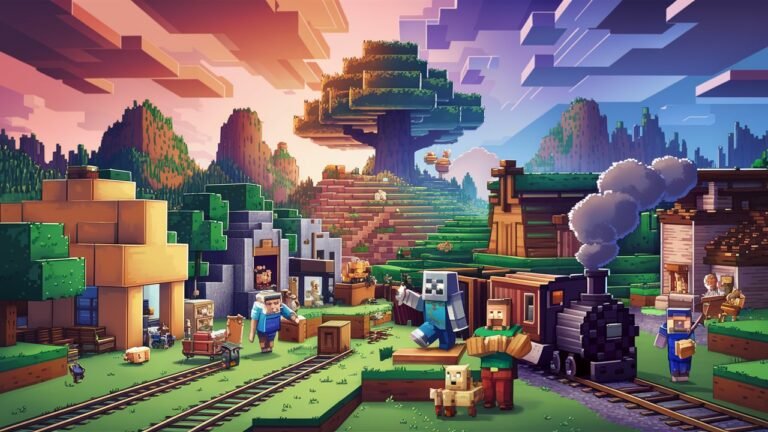Eaglercraft, a browser-based adaptation of Minecraft, has captivated players and developers alike by offering a lightweight, accessible version of the iconic sandbox game. However, the term “unminified Eaglercraft“ has recently gained traction in tech and gaming communities, sparking curiosity about its implications. This article delves into the concept of unminified Eaglercraft, exploring its technical foundations, practical applications, and the opportunities it unlocks for customization, education, and community-driven development. Whether you’re a developer, educator, or enthusiast, understanding unminified Eaglercraft is key to unlocking its full potential.
What Is Unminified Eaglercraft?
To grasp the significance of unminified Eaglercraft, it’s essential to first understand minification. Minification is a process used in software development to remove unnecessary characters (like whitespace, comments, and line breaks) from code, reducing file size and improving load times. While this optimizes performance, it also renders the code unreadable to humans.
Unminified Eaglercraft refers to the original, human-readable version of the Eaglercraft source code before undergoing minification. This code retains its structure, comments, and descriptive variable names, making it easier for developers to study, modify, and extend. Unlike the compressed version deployed in browsers, unminified code serves as a blueprint for customization, troubleshooting, and learning how the game functions under the hood.
The Importance of Unminified Code in Development
Unminified code is a treasure trove for developers and hobbyists. For Eaglercraft, this version provides several critical advantages:
- Readability and Learning: Minified code strips away context, making it nearly impossible to decipher. Unminified Eaglercraft, however, allows developers to follow logic flows, understand dependencies, and learn how browser-based games leverage technologies like WebGL and WebSocket.
- Debugging and Troubleshooting: When errors arise, unminified code simplifies identifying issues. Descriptive variable names and comments act as guideposts, reducing the time spent tracing bugs.
- Customization and Modding: Unminified code is the foundation for creating mods, tweaking gameplay mechanics, or adding new features. For instance, altering rendering logic or integrating new block types becomes feasible with access to the original codebase.
- Collaboration: Open-source projects thrive on readable code. Unminified Eaglercraft fosters community collaboration, enabling developers to contribute fixes, optimizations, or innovative features.
Technical Breakdown: How Unminified Eaglercraft Works
Eaglercraft’s unminified codebase is structured around core components that replicate Minecraft’s functionality in a browser environment. Key elements include:
Client-Server Architecture
Eaglercraft uses a client-server model where the browser acts as the client, communicating with a backend server. The unminified code reveals how WebSocket protocols handle real-time interactions, such as block placements, player movements, and multiplayer synchronization.
Rendering Engine
The game relies on WebGL for 3D rendering. Unminified code exposes the shaders and rendering pipelines that convert block data into visual elements. Developers can study how textures are applied, lighting is simulated, and chunks are dynamically loaded.
Game Mechanics and Physics
From gravity to collision detection, Eaglercraft’s physics engine is simplified but functional. The unminified code provides insights into how entities (like players and mobs) are managed, inventory systems are structured, and world generation algorithms operate.

Customizing Unminified Eaglercraft: Use Cases
Access to unminified code unlocks endless possibilities for customization. Here are popular use cases:
Building Custom Mods
Developers can create mods to introduce new items, biomes, or gameplay rules. For example, a “portal gun” mod could be developed by modifying entity interaction logic in the unminified code.
Enhancing Performance
By analyzing rendering loops or network handlers, developers can optimize resource-heavy processes. This is particularly useful for users on low-end devices.
Educational Projects
Educators use unminified Eaglercraft to teach programming concepts. Students can modify code to see immediate visual results, such as changing block colors or adjusting movement speed.
Private Server Customization
Server hosts can tweak gameplay settings, implement anti-cheat systems, or add custom plugins by modifying server-side logic in the unminified code.
Challenges and Considerations
While unminified Eaglercraft offers flexibility, it also presents challenges:
- Performance Overheads: Unminified code is larger and slower to execute. Developers must re-minify their modifications before deploying them in production environments.
- Security Risks: Exposing raw code can reveal vulnerabilities. Malicious actors might exploit weaknesses in custom implementations, especially in multiplayer setups.
- Legal and Ethical Concerns: Distributing modified versions of Eaglercraft may infringe on intellectual property rights. Always verify licensing terms before sharing derivatives.
The Role of Unminified Eaglercraft in the Community
The availability of unminified code has fueled a vibrant open-source community. Platforms like GitHub host forks where developers share optimizations, mods, and experimental features. Additionally, forums and Discord servers serve as hubs for troubleshooting and collaborative projects. Educational institutions have also adopted Eaglercraft as a teaching tool, using its codebase to demonstrate real-world applications of JavaScript and game development principles.
Conclusion
Unminified Eaglercraft represents more than just a readable codebase—it’s a gateway to innovation, education, and community engagement. By providing transparency into the game’s inner workings, it empowers developers to push the boundaries of browser-based gaming. However, with great power comes responsibility: developers must balance creativity with performance, security, and legal compliance. As the ecosystem around Eaglercraft grows, the unminified version will remain a cornerstone for those eager to explore, learn, and build.
Frequently Asked Questions (FAQs)
1. What is the difference between minified and unminified Eaglercraft?
Minified Eaglercraft is optimized for performance, with all unnecessary characters removed. Unminified Eaglercraft retains human-readable code, including comments and structured formatting, making it ideal for development and learning.
2. Can I legally modify and redistribute unminified Eaglercraft?
This depends on the project’s licensing. Always review the original license terms. Many community versions operate under open-source licenses, but redistribution of modified code may require attribution or adherence to specific guidelines.
3. How does unminified code affect game performance?
Unminified code is larger and slower to load. It’s recommended to minify custom builds before deploying them for public use to ensure optimal performance.
4. What tools are needed to work with unminified Eaglercraft?
A code editor (e.g., VS Code), a modern browser for testing, and build tools like Webpack for minification are essential. Knowledge of JavaScript, WebGL, and WebSocket protocols is beneficial.
5. Where can I find the unminified Eaglercraft code?
The code is often available on GitHub repositories or developer forums. Ensure you download it from trusted sources to avoid malicious modifications.
